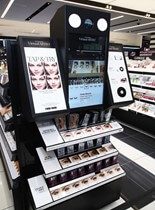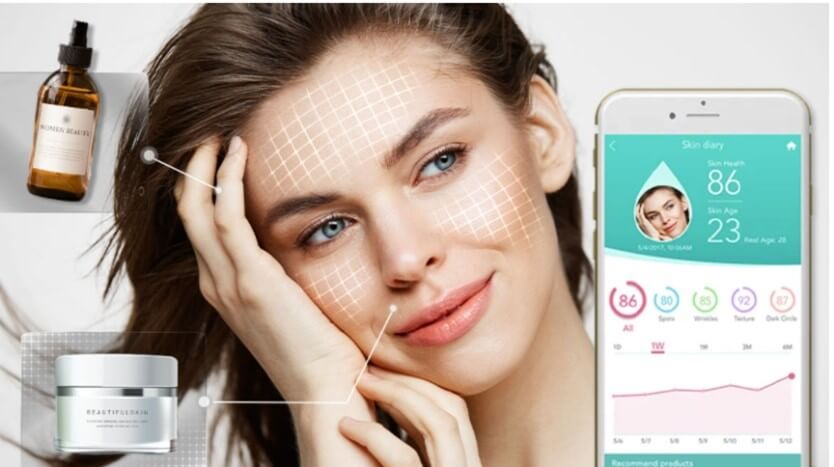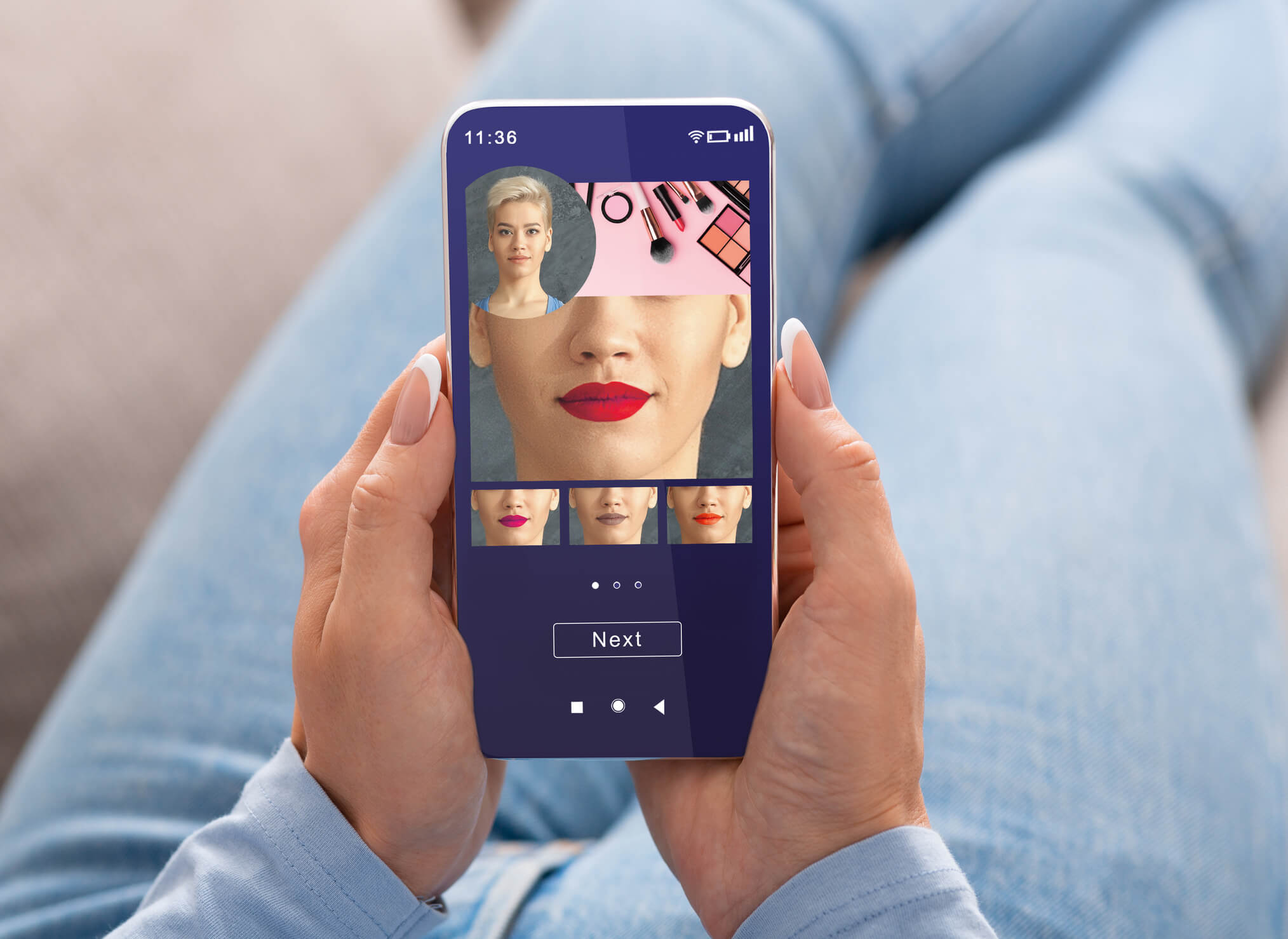"Who hasn't dreamed of being able to try on several lipsticks in less than 1 minute?" That's the challenge many beauty brands want to take up.
The current health crisis has forced companies to rethink their customer commitment. Testers, key decision-makers for many cosmetics stores, need to be reinvented. "The art of gifting", an essential ceremony in the beauty sector, must continue. Not to mention the importance of maintaining a relationship of trust with customers from a distance. These are the many challenges facing the entire sector, but there remains a source of hope thanks to new tools.
But what are augmented reality, virtual reality and artificial intelligence? What are the differences, and what are the challenges facing the beauty industry in the future?
What are the differences between virtual reality and augmented reality? Where does artificial intelligence fit in?
Virtual reality, augmented reality and artificial intelligence are not new concepts. However, they are much talked about because they enrich the customer's shopping experience.
However, these technologies should not be confused and have different uses.
Unlike virtual reality, which creates an artificial universe, augmented reality enriches reality with virtual elements.
In more detail, the aim of virtual reality is to use technology to recreate a digital experience. It involves using technology to immerse users in a totally artificial world, which can be inspired or totally invented. It's an opportunity for users to enjoy a unique experience in a world that appeals to all 5 senses.
The aim of augmented reality is to erase the boundaries between our world and virtual "data". Using a simple smartphone camera, we can replicate digital content in the physical world. The vision of reality is thus altered by the digital elements superimposed on it.
In contrast ,artificial intelligence uses different algorithms to simulate human intelligence. These concepts apply very well to the cosmetics sector, since they enable us to respond to customized needs and provide greater personalization.
How is technology transforming the cosmetics industry?
The Virtual Try-on tester
COVID has led to the closure of many non-essential stores and businesses. Testers have disappeared from counters, and every product handled has to be disinfected. To the point where it has become impossible to test cosmetics at the point of sale. As the beauty industry relies on the 5 senses, it's important to continue trying out products as much as possible.
This is where augmented reality, virtual reality and artificial intelligence come into play to support these new purchasing behaviors.
Over the past year, these tools have become indispensable in the industry for attracting customers. Several beauty brands, such as L'Oréal, Chanel and Charlotte Tilbury, have evolved their applications to incorporate these new technologies. They have quickly grasped the need for consumers to continue their cosmetics purchases even in times of Covid.
A new level of intimacy has been established between brands and their customers.
The websites of cosmetics brands such as NYX and Clarins offer their customers the Virtual Try-on option. Consumers can quickly test several shades of the product of their choice and see the result in real time.

Some brands, such as Lancôme, have even managed to recreate a totally virtual boutique. Customers can stroll through the aisles and interact with various functions.
It's a virtual journey into the world of brands.
The opportunities for creating a bond and engagement with the customer are infinite. Point-of-sale events can be organized to win testers and promote new products. Virtual reality can be used to create a virtual treasure hunt. It's a personalized and privileged moment for the consumer to have a unique and memorable experience.
This perfectly meets the needs of consumers who want to experiment with new products and continue to receive expert advice and guidance. Thanks to these new features, they'll be more inclined to try out new colors, false eyelashes, lipsticks and eyeshadows.
However, we shouldn't expect online virtual testers to completely replace in-store ones. Although sales on e-commerce sites are on the rise during the containment period, they are not sufficient to offer a similar, unique experience to those in-store. Point-of-sale sales are necessary, indeed crucial, if brands are to continue to grow.
According to Euromonitor's annual Beauty Survey 2020, stores remain an important place for consumers to ensure the right color and shade. Nearly 80.7% of the world's cosmetics purchases are made in-store.
Contact andexpertise with live "beauty advisors" cannot therefore be totally replaced by the virtual in this sector. Particularly for products that requireexpertise beauty advisors to properly support customers.
Hence the usefulness of "Virtual Try-on" technology, which can be used not only on e-commerce sites, but also in-store.

Interactive kiosks are key tools for testing new products. A case in point is Sephora, which provides its customers with virtual advisors, product presentation tools and QR codes in its stores. By scanning these QR codes with their Smartphone, customers are able to access an interface of Virtual Try-on and other features.
We are thus witnessing an increase inomnichannelity, as described by L'Oréal's new CEO, Nicolas Hieronimus, in an interview with AFP: "an ecosystem where the consumer moves from one to another".
Social networks under attack
With the Covid crisis, consumers have had to adopt new ways of shopping. The rise of e-commerce has become the most suitable option for buying cosmetics. According to the annual Beauty Survey, over 31.3% of consumers bought a beauty product on the Internet in 2020. This shows the importance of this channel for the sector.
But it's the social networks in particular that are taking advantage of this trend to develop and enrich their platforms. It's an opportunity to foster engagement and offer customers a richer experience. Here's how these technological tools are being used:
In recent years, Facebook has invested heavily in new technologies. By partnering with the L'Oréal group, Facebook is integrating augmented reality and artificial intelligence into its platform. This technological advance will enable buyers to test cosmetic products, making their experiences even more enriched and personalized.

The inspiration site visited by millions of users has also ventured into augmented reality for cosmetics. There was already a feature enabling items to be purchased directly online. But it's only since 2020, that it's possible to try out various lipstick colors from brands like NYX. This new feature also features a filter capable of adapting to the customer's skin tone to ensure the right representation for all skin tones.
Instagram is one of the most widely used platforms in the beauty sector. With an average engagement rate of 1.07% according to Emarketing.fr, the app has gradually overtaken Snapchat by taking control of augmented reality and combining it with live shopping organized by beauty influencers. Instagram offers its users the opportunity to test, try and buy live the products mentioned in the live.
- Tik Tok
The most popular site among beauty influencers and young people alike, has also chosen the path of augmented reality. It's a community that's not afraid to try new things, and regularly launches new trends. With the highest rate of engagement, Tik Tok is gaining ground.
Which companies are making these technological advances possible in the sector?
The alliance between cosmetics brands and companies like Perfect Corp helps to improve the customer experience by combining the customer data collected by the brands with the technology and know-how of these companies. Cosmetics brands stand out from their competitors and in the eyes of their customers thanks to in-depth and precise support, making the shopping experience just as dynamic whether in-store or online.
So it's only natural that AI should also find its place, offering a "complete diagnosis" type of analysis to unearth one's new foundation, perfect eye cream or even a new perfume. This becomes a real asset, especially for brands wishing to set up e-consultation sessions.
- The collaboration between L'Oréal and ModiFace
ModiFace is an app acquired by L'Oréal in 2018 whose main aim is to promote augmented reality and artificial intelligence, tailored to suit each of their offerings. The use of this app has concrete effects for L'Oréal's flagship brands. It is now possible for consumers to try out products virtually, through applications such as Style My Hair, which offers coloring simulations, or the NYX Professional Makeup application in the United States, for virtual make-up tests. The aim is to guide the user, reducing dissatisfaction andincreasing product knowledge.
-

Artificial intelligence interface on Perfectcorp.com YouCam Makeup, the application published by Perfect Corp
Perfect Corp positioned itself as leader on the beauty tech market with the launch of its YouCam Makeup app. Thanks to its perfect mastery of artificial intelligence and augmented reality, the company has succeeded in offering users a unique and dynamic experience. This explains why over 40 brands (Mac cosmectics, Estée Lauder...) have placed their trust in the company. From skincare to make-up, no category is excluded by this technology.
What does the future hold for the beauty sector?
The digital website is energizing the beauty sector, and it's working, because the industry relies heavily on the visual. Consumers therefore expect one thing: to try out new techniques and products and learn how to apply them. Masterclasses are a great success. The aim is to educate consumers directly at home, just as they might do in-store, which in turn increases online sales.
It would seem that the brands that are most oriented towards digital will be best positioned to succeed in this new environment. Thus, the emerging trend is to move from a classic cosmetics brand to a "Beauty Tech" brand. The benefits of augmented reality, virtual reality and artificial intelligence will continue beyond the pandemic. Not only will consumers be accustomed to online shopping, they will also be ready to explore innovative new opportunities.
--------
Sources :
- Le Figaro Economie - Cosmetics: an increasingly connected world, predicts L'Oréal's new boss
- Cosmeticobs - Post-Covid-19: the outlook for the cosmetics sector according to Euromonitor
- L'Oréal - Discover ModiFace
- Perfect Corp

